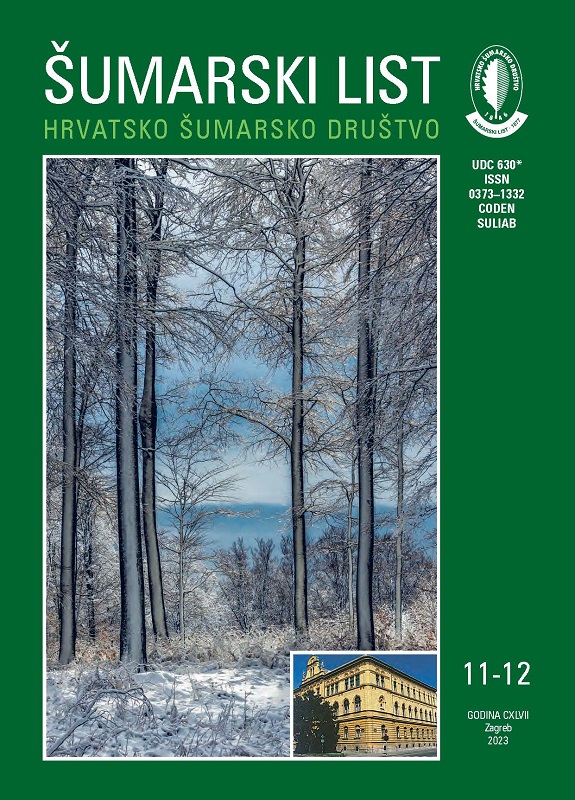
broj: 11-12/2023
pdf (9,99 MB) |
|
||||||||||||||
| RIJEČ UREDNIŠTVA | ||
| Uredništvo | ||
| At the end of 2023 pdf HR EN | 503 | |
| IZVORNI ZNANSTVENI ČLANCI | ||
| Damir Drvodelić, Milan Oršanić, Damir Ugarković, Mario Šango | UDK 630* 232.3 (001) https://doi.org/10.31298/sl.147.11-12.1 | |
| Comparison of vitality and laboratory germination of holm oak acorns (Quercus ilex L.) pdf HR EN | 505 | |
| Nera Bakšić, Darko Bakšić | UDK 630* 114 (001) https://doi.org/10.31298/sl.147.11-12.2 | |
| Forest floor fuel loads in holm oak (Quercus ilex L.) and pubescent oak (Quercus pubescens Willd.) forests pdf HR EN | 513 | |
| Summary The application of newer remote sensing methods, such as aerial and terrestrial lidar scanning and the use of "Structure-from-motion" (SfM) photogrammetry, complemented field data collection and enabled 3D mapping of forest fuel layers, greatly simplifying and improving their characterization. However, these methods are not suitable for quantifying forest floor characteristics. For this purpose, it is still necessary to collect data using classical field methods, determining the presence of subhorizons and their depth, while the characteristics of the forest floor: bulk density, load, carbon concentration and carbon stock are determined in the laboratory. Therefore, it is still common practice to create regression equations that allow operatives to determine the amount of available forest floor fuel and the carbon stock it contains based on the depth of the forest floor, which is an easily measurable variable, or to determine forest floor loading by subhorizon and overall. Forest floor information is used in models for predicting forest fire behavior and spread, in fire effects models, in planning and monitoring mechanical fuel reduction, in quantifying fuel consumption and smoke emissions, in quantifying carbon stocks, in describing habitat and its productivity, and in planning for preparedness. As stands of holm oak (Quercus ilex L.) and pubescent oak (Quercus pubescens Willd.) are located in the Mediterranean part of Croatia, where the risk of forest fires is the highest, and the previously published data on the forest floor are not suitable for the models, the main objectives of the research were to determine the depth, bulk density and load of individual subhorizons of the forest floor and to create regression equations that allow estimating the amount of available fuel in the forest floor based on its depth. Sampling of forest floor in holm oak stands (60, 90 and 100 years old) was conducted on the islands of Lastovo and Mljet, while sampling in pubescent oak stands (53 and 90 years old) was conducted in Dugopolje and Biograd na Moru. The amount of forest floor and OC stock in old stands of holm oak and pubescent oak is twice as small as in old stands of Aleppo pine and Dalmatian black pine. This suggests that pine stands have a significantly greater amount of potentially available fuel in the forest floor and are therefore potentially more at risk from fire, but also that they store twice as much carbon in the forest floor. In this study, for the first time in Croatia, bulk densities of individual subhorizons of the forest floor were determined for holm oak and pubescent oak and regression equations were created that allow estimating the amount of available fuel in the forest floor based on its depth per subhorizon and overall. The results of this research have practical value in simpler quantification of forest floor fuel loading, which is important for operational use of models to predict forest fire behavior and spread, but they can also be used in other models mentioned earlier. Key words: holm oak; pubescent oak; forest floor; forest floor fuel loads; carbon stocks | ||
| Mirzeta Memišević Hodžić, Sulejman Sinanović, Dalibor Ballian | UDK 630*164 (001) https://doi.org/10.31298/sl.147.11-12.3 | |
| The relationship of growth characteristics and wood quality on the experimental plot of larch pdf HR EN | 525 | |
| Biljana M. Nikolić, Katarina Mladenović, Ljubinko Rakonjac, Slobodan Milanović, Marija M. Marković, Srdjan Bojović, Nevena Čule | UDK 630*164+272 (001) https://doi.org/10.31298/sl.147.11-12.4 | |
| Influence of crown exposure on the morphological needle traits of nine conifers pdf HR EN | 535 | |
| PRETHODNO PRIOPĆENJE | ||
| Jovana Devetaković, Milutin Đilas, Ivona Kerkez Janković | UDK 630*164 https://doi.org/10.31298/sl.147.11-12.5 | |
| Stocktype impact on survival and growth of one-year old Quercus pubescens seedlings on the edge of Panonnian basin pdf HR EN | 547 | |
| STRUČNI ČLANCI | ||
| Saša Bogdan, Ida Katičić Bogdan, Martina Temunović | UDK 630* 232.3 https://doi.org/10.31298/sl.147.11-12.7 | |
| On the use of foreign forest reproductive material for the regeration of local stands of pedunculate oak from the stand points of a genetics pdf HR EN | 565 | |


